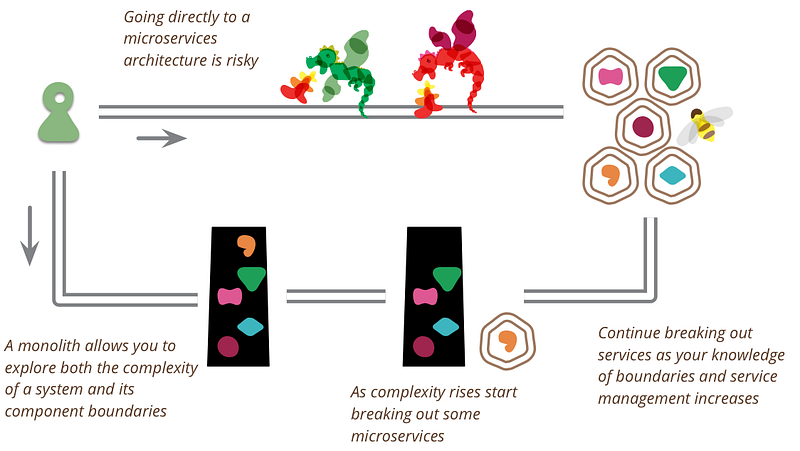Originally published on medium

on [Unsplash](https://unsplash.com/search/photos/containers?utm_source=unsplash&utm_medium=referral&utm_content=creditCopyText)](https://cdn-images-1.medium.com/max/2560/1*ZtB3bSD2qOkRT3xJ_5gDQg.jpeg)
This year I decided to work on a side project and these are part of my notes about it.
Recently I found myself in a situation when I was jumping in on a project, while the core developer was jumping out of the project, a very common thing on startups. After a soft onboarding (no onboarding), they gave me access to the codebase, there were 8 repositories. Microservices. This type of approach to application development has got a lot of attention in the last years, there are a lot of blog posts on the topic, a lot of talks about the benefits of microservices based architecture.
I had never worked on a project with this architecture before. I had never wanted to work with this before. So I decided to study a little bit more about the topic, my bigger source was the book Python Microservices Development, and also some other blog posts, and here are my notes, my questions, my concerns, and my angry thoughts about it.
Monolith
All my previous experiences were with Monolithic applications, these applications can be described as:
A monolith is a single program that runs in a single process. — James Shore
Usually, this type of application has all the required components included. Here’s a more visual representation of this formal concept:

All the work is made for a single part of the application. There are a lot of benefits of this type of application, for example: building a good test coverage is easy, you can organize your code in a clean and structured way inside the code base. Since all your data is into a single database the development of the application is simplified. Testing our application in an end to end matter is simple. The deployment is also a no problem: we can tag the code base, build a package, and run it somewhere, Heroku for example (I’m a big fan of Heroku).
To be successful with a monolith, you need careful design to make sure different parts of the program are isolated. Sometimes even if you try things can still be really coupled together. And the more teams you have, the more difficult it is to maintain the concerns separated.
Microservices
So, as I said microservices is one the most hyped contents around software development, let’s start by going through its origins:
The origin of this architecture often mentions Service-Oriented Architecture (SOA), the core principle is the idea that you organize applications into a discrete unit of functionality that can be accessed remotely and acted upon and updated independently. Each unit in this preceding definition is a self-contained service, which implements one facet of a business, and provides its feature through some interface. However, it is common to say that microservices are one specialization of SOA.
This type of architecture is seen as a solution to the dependency on the monolith.
A microservice is a lightweight application, which provides a narrowed
list of features with a well-defined contract. It’s a component with a single
responsibility, which can be developed and deployed independently.

At first glance, microservices seem like the perfect solution to all the disadvantages of the monolith. Each microservice is a small, self-contained program. Developed completely independently, with its own repository, database, and tooling. Services are deployed and run separately, so it’s literally impossible for one team to inappropriately touch the implementation details of another. Unfortunately, microservices move the coordination responsibility from development to operations. Instead of deploying and monitoring a single application, ops has to deploy and monitor dozens or even hundreds of services.
On this part of my research, a lot of comparisons came up like: “Monolith applications are unreliable, not fit for complex applications, unscalable and many other things, and microservices is the solution to all of these problems.” But of course, let’s get into that.
Microservice benefits
While the microservices architecture looks more complicated than its monolithic counterpart, its advantages are multiple:
- Separation of concerns
- Smaller projects to deal with
- More scaling and deployment options
Microservices pitfalls
You need to be aware of these main problems you might have to deal with when coding microservices:
- Illogical splitting
- More network interactions
- Data storing and sharing
- Compatibility issues
- Testing
Monolith vs Microservices
One thing that stuck with me was the Illogical splitting. According to the book Python Microservices Development:
“The first issue of a microservice architecture is how it gets designed. There’s no way a team can come up with the perfect microservice architecture in the first shot. The design needs to mature with some try-and-fail cycles. Adding and removing microservices can be more painful than refactoring a monolithic application.”
You can mitigate this problem by avoiding splitting your app in microservices if the split is not evident.
Premature splitting is the root of all evil
This specific point stuck with me. Did previous developers take the wrong road when they decided to build a microservices architecture for a startup project since the beginning?
“…and we didn’t even launch yet”
Luckily, there are a lot of posts written by far more experienced people to bring a light on this discussion. A great source of study is the Martin Fowler blog if you don’t know Fowler you should, he’s an author, speaker, and loud-mouth on the design of enterprise software. I wanna focus on two articles: MonolithFirst and Don’t start with a monolith].
Monolith First
Fowler stars this post with two statements that came from his experience with software development:
- Almost all the successful microservice stories have started with a monolith that got too big and was broken up
- Almost all the cases where I’ve heard of a system that was built as a microservice system from scratch, it has ended up in serious trouble.
You shouldn’t start a new project with microservices, even if you’re sure your application will be big enough to make it worthwhile. — Martin Fowler

The main reason for him is the classic Yagni (You Aren’t Gonna Need It). When you’re building a product for a startup how sure are you that your product is gonna stick? How sure are you that is gonna be a success? The best way to find out is to build a simplistic version and see how well it works.
Don’t start with a monolith
The full title is: “Don’t start with a monolith … when your goal is a microservices architecture”. This post was written by Stefan Tilkov, he starts with:
I’m firmly convinced that starting with a monolith is usually exactly the wrong thing to do. — Stefan Tilkov
He states that in the majority of cases, it will be extremely hard to cut up an existing monolith system. This is coupled with the way you develop your monolithic application if you are able to build a well-structured monolith you have no need of microservices. However, the reality is quite different:

Microservices main benefit, in my view, is enabling parallel development by establishing a hard-to-cross boundary between different parts of your system. In theory, you don’t need microservices for this if you simply have the discipline to follow clear rules and establish clear boundaries within your monolithic application.
I strongly believe — and experience from a number of our recent projects confirms this — that when you start out, you should think about the subsystems you build, and build them as independently of each other as possible. — Stefan Tilkov
…
In the end, the answer to the architectural decision is: https://twitter.com/KentBeck/status/596007846887628801